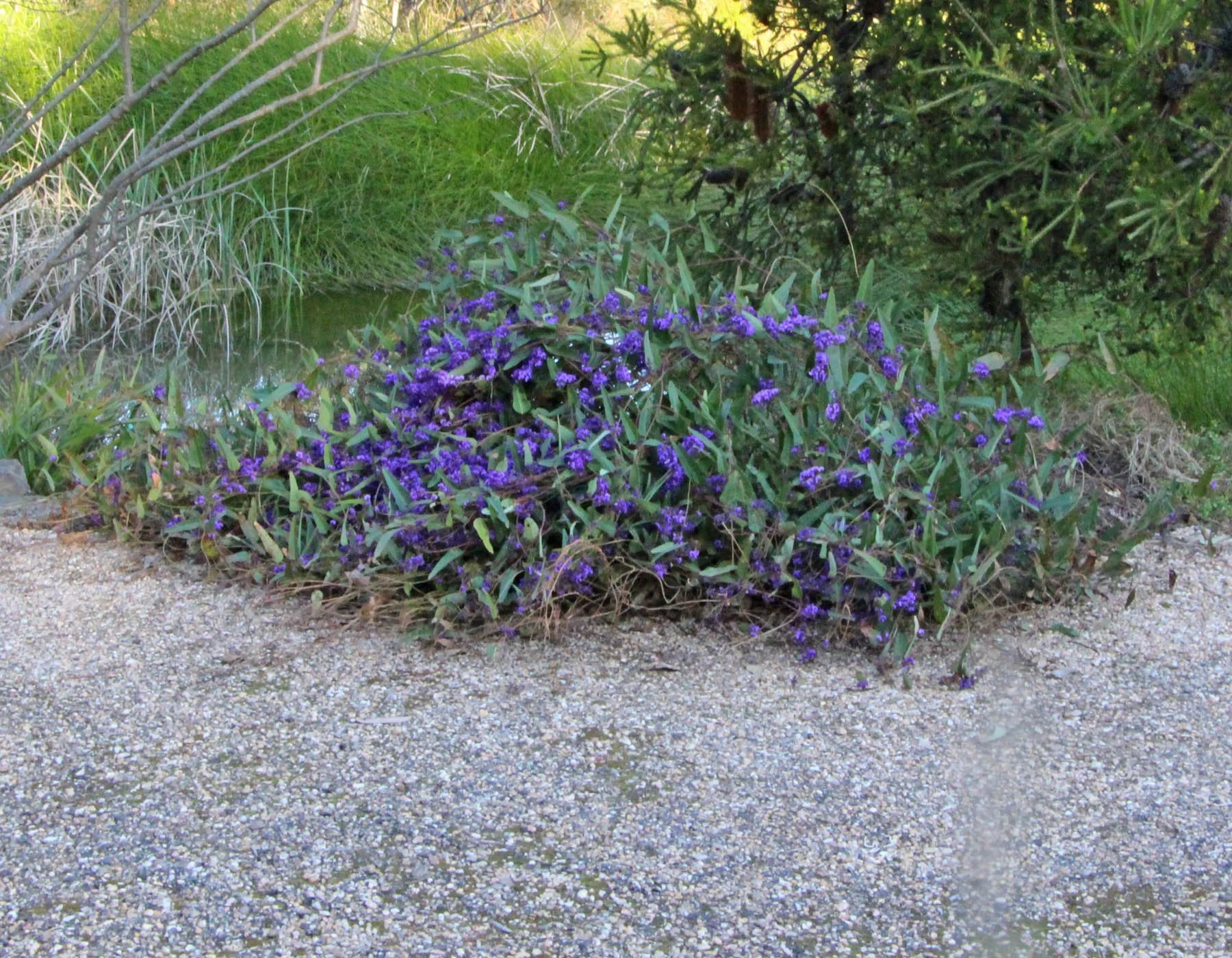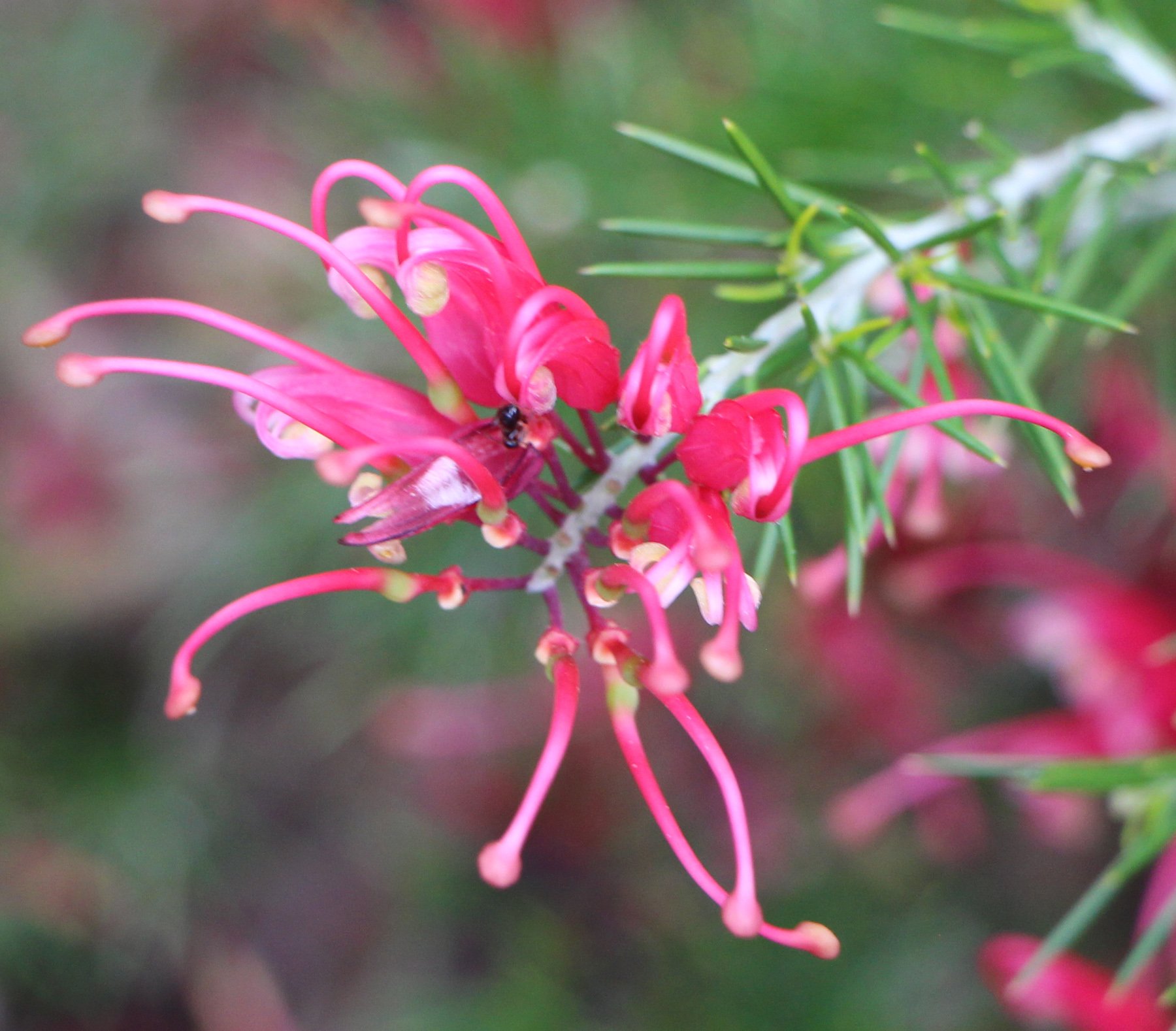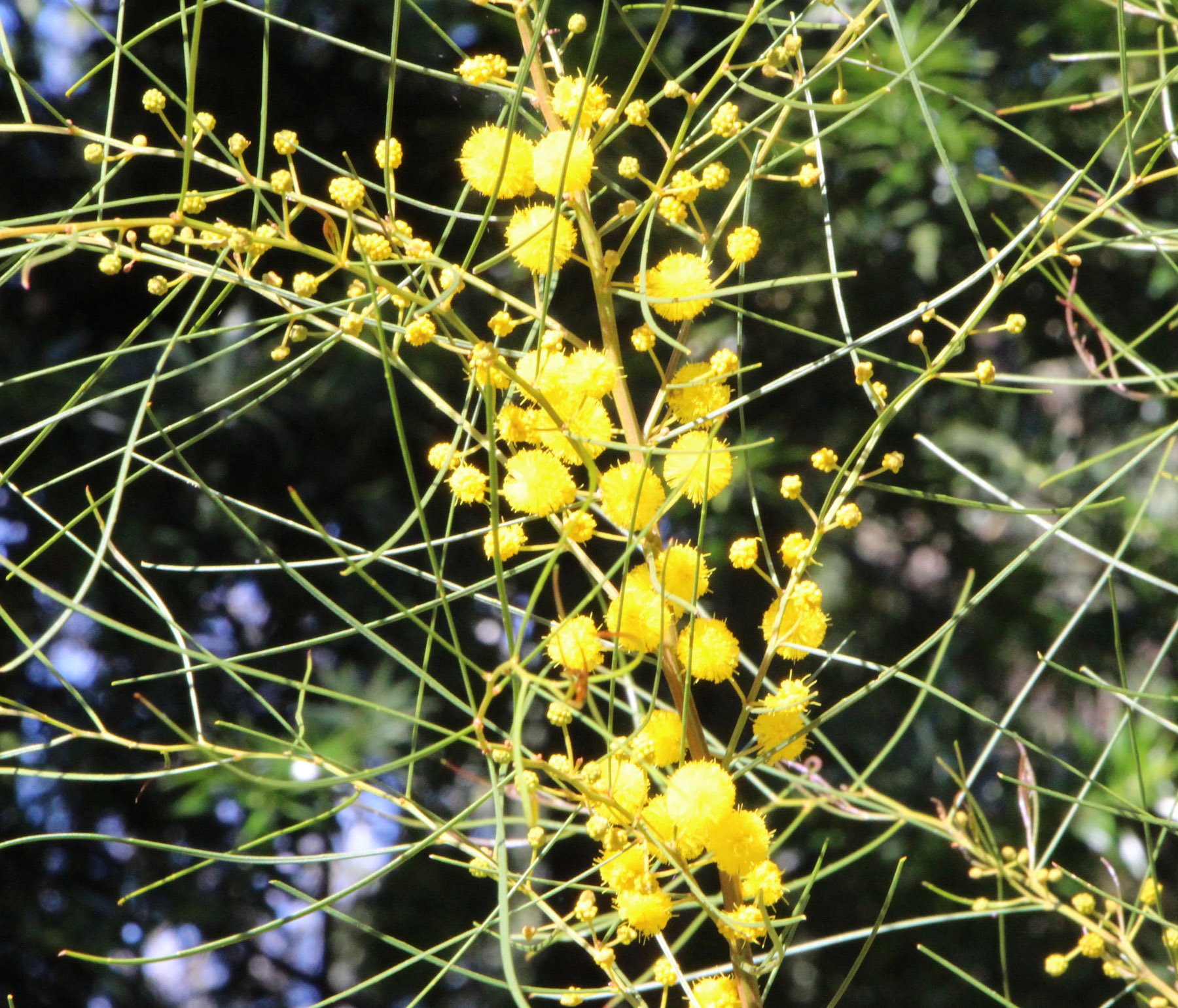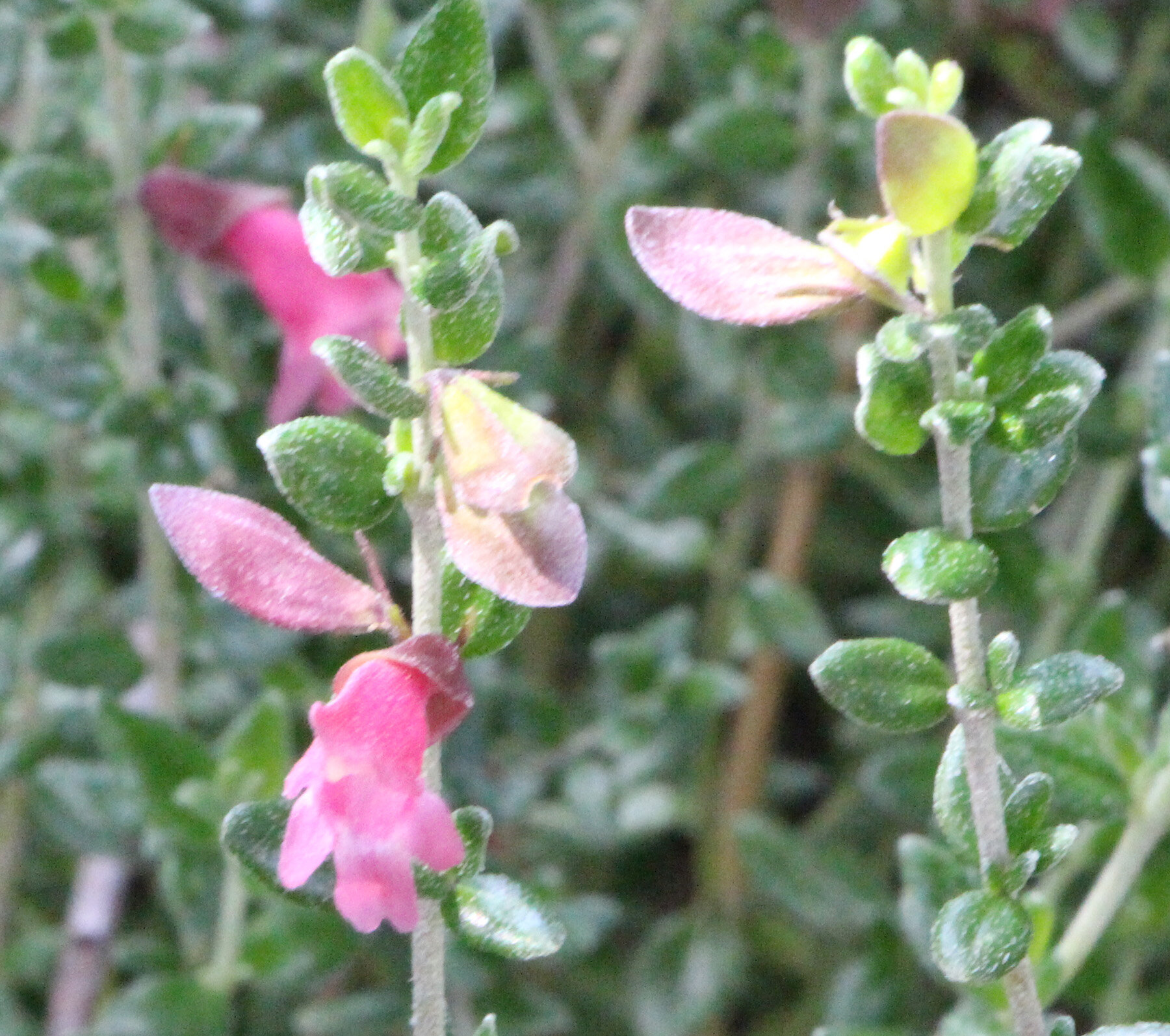September
Some plants that bloom in September
Click on any image to enlarge and scroll though all the images for each week
Grevillea ‘Peaches and Cream’
23 September 2024
Starting from the top left:
Acacia dangarensis
We planted this small tree to 10 metres in February 2013, with smooth grey bark, frond-like foliage and golden-yellow flowers produced in sprays from August to September. Acacia dangarensis is endemic to NSW and confined to the summit and surrounding slopes of Mount Dangar south of Merriwa, within Goulburn River National Park. The total population size of Acacia dangarensisis estimated to be of the order of 1750 plants extending over an area of about 70 hectares and is not known to occur in any other location. Our tree tipped over in windstorm in December 2020 and we have now braced it to the fence. Best bloom so far in September 2023. This tree is growing tall, July 2024.
Acacia pravissima prostrate ‘Bushwalk Baby’
We have planted ten of these prostrate plants, width 1.5m, with grey green foliage and a showy display of brilliant yellow flowers, from 2008-16. Some of them have proved to be prostrate as advertised and others have grown into upright bushes. Only one persists now, which has spread widely and flowers well each year.
Grevillea ‘Crimson Villea’
We have planted eight of these compact grevilleas with masses of showy crimson winter flowers, 80cm x 80cm, the first in February 2020, then others in 2021-23. This cultivar of G. rosmarinifolia had its first flowers for us in September 2020, forms a dense bush and flowers over a long period.
Grevillea juniperina prostrate form
We planted this vigorous groundcover, to 2m wide, with dense foliage and red spider flowers in November 2022. This plant prefers a sunny site with moist well drained soils and is native to eastern NSW and southeastern Queensland, where some subspecies are listed as vulnerable.
Hakea nitida - Shining Hakea
We planted Hakea nitida, or Shining Hakea, in March 2010 and it has grown to 2m x 2m of prickly, green, toothed foliage, definitely a useful plant to form a barrier. Evidently this plant can grow to 4m x 5m, but is still much smaller than that in our garden. The flowers are very attractive, pink and white, occurring each spring since 2012. This plant is native to southwestern WA.
Prostanthera incisa
We love Prostanthera incisa and have planted 11 of these from 2012-2019. This plant grows to a rounded shrub 1.5m high and wide with small, toothed, very fragrant leaves and violet flowers. It is a great plant to trail your hand over at any time of the year. We did discover that these plants are very sensitive to lack of water and need consistent moisture throughout the summer. We have trimmed ours back many times and they respond vey well. This plant is native to rocky hilltops of eastern mainland Australia. Removed four of these large older plants in March 2023.
9 September 2024
Starting from the top left:
Acacia gracilifolia – Graceful Wattle
We planted one of these slender upright shrubs, to 2m high, with very fine phyllodes and gold ball flowers in October 2011. This plant developed scale and we removed it in November 2014. We planted another specimen in November 2019 and this one persists and is wonderful in bloom. This plant is native to Flinders Ranges, Mt. Lofty Ranges, Port Pirie, South Australia. One large limb came off in a windstorm March 2023.
Acacia pravissima ‘Little Nugget’ – Ovens Wattle
We planted four of this dwarf form of Ovens Wattle, height to 1.5 m, a low branching bushy shrub with drooping greyish foliage and yellow flowers in 2003-4. The young growth has an attractive bronze purple sheen during winter. These plants quickly outgrew their position to 2m high x 3m wide and were removed. We planted another two in October 2018 in a more spacious position and these are growing well and flowering prolifically.
Banksia praemorsa ‘Red Dawn’
We planted this bushy shrub in a pot in February 2020, 2-4m high x 2-3m wide, with burgundy flowers with green, yellow and pink as the flower develops. Banksia praemorsa is native to Albany WA.
Hakea clavata
We have planted two of these shrubs, 1.5m high x 2.5m wide, with succulent like leaves and pale pink to white flowers, in March 2012 and November 2019. The foliage is unusual and a feature of the plant. Our first specimen, planted in March 2012, was hit by the frost in October of the same year and died. The second one we planted in pot in November 2019 and it is growing well so far and flowered for the first time in October 2021. Rhodanthe anthemoides has colonized the pot filling the lower parts in 2024. This plant is native to the Esperance area of WA and is adapted to harsh conditions.
Hardenbergia violacea
Ground cover or trailing plant to 1.5m wide with lance-shaped leaves with many purple flowers in spring. Needs a full sun to partly shaded position in well-drained soils and can be pruned hard. Does have some frost damage so not for frost hollows. Native to southeastern Australia.
Leionema ‘Green Screen’
We have planted seven specimens of this hybrid between L elatius and L. lamprophyllum, a dense, vigorous, compact shrub, 2m high and wide, with bright green aromatic foliage and honey scented clusters of white star flowers, from 2011-2020. This plant will grow in heavy or light soils with average drainage, in full sun to part shade, and is hardy to moderate frost and extended dry periods. Our original plant had nothing green about it – it turned a burgundy colour in April 2011, never looked healthy and was removed in February 2012. Another plant died in the heat in December 2018 and another in December 2019. We now have three established and flowering well in September 2020.
25 September 2023
Starting from the top left:
Acacia floribunda ‘Little Flori’
We have planted two of these mounding shrubs, 60cm x 1m wide. with green feathery leaves and bright yellow flowers in 2019 and 2020.
Grevillea anethifolia
Our original plant of Grevillea anethifolia was given to us by Neil Marriott in 2014 and has proved very attractive in the garden. This plant is not endangered in the wild in WA and SA, but much of its natural habitat in NSW has been cleared. This plant suckers freely and supplies plenty of new plants for sharing. The foliage is dense and intricate, light green and the white flowers are prolific in spring. This plant should be cut back after flowering and will reward you with new growth.
Grevillea ‘Crimson Villea’
We planted this compact grevillea with masses of showy crimson winter flowers, 80cm x 80cm, in February 2020. This cultivar of G. rosmarinifolia had its first flowers in September
Grevillea lanigera ‘Celia’
We planted three of these low hardy shrubs, 45cm high x 1m wide, with pink and white flowers, in 2018.. This plant needs full sun and is frost hardy, and the flowers attract birds.
Nematolepsis frondosa
Previously Phebalium frondosum. We planted this erect shrub, 1.5-3m high x 1-1.5m wide, with very dark green fragrant foliage and white flowers, in September 2023. This plant grows best in full sun or part shade in well drained acidic soils and is frost and snow tolerant. Threatened species.
Rhodanthe anthemoides ‘Paper Cascade’, ‘Paper Star’, ‘Southern Stars’, ‘Starshower’ and ‘Sunray Snow’
We have planted more than 60 of these perennial everlasting daisies, 0.3 m high x 1m wide, with aromatic grey leaves and white papery flowers in summer, often pink in bud, from 2004 onward. These sub-alpine plants prefer a well drained, mulched sunny position, but thrive with some overhead protection in our garden. Slugs love them – put down slug deterrent.
11 September 2023
Starting from the top left:
Acacia gracilifolia – Graceful Wattle
We planted one of these slender upright shrubs, to 2m high, with very fine phyllodes and gold ball flowers in October 2011. This plant developed scale and we removed it in November 2014. We planted another specimen in November 2019 and this one persists. This plant is native to Flinders Ranges, Mt. Lofty Ranges, Port Pirie, South Australia.
Acacia rubida – Red Stemmed Wattle
We planted this small tree, with light green foliage and yellow flowers, in July 2005. This is a hardy wattle which tolerates most soils, dryness and frost and is native to Victoria, ACT, NSW and Queensland.
Eremophila cuneifolia - grafted
We planted this bushy shrub, 1.2-1.5m high, with mauve/pink flowers over many months, in February 2018. Be careful to remove any Myoporum rootstock. This plant is native to the Pilbara region, WA.
Grevillea ‘Winter Kiss’
We planted this low ground coverer, 0.15m high x 1m wide, with small bright green leaves and many red and cream spider flowers, in February 2015. This is a hardy plant and attractive to birds.
Kunzea affinis
We planted this shrub, 0.7 – 2.5m high x 0.7 – 2.5m wide, with bright green foliage and many bright pink flowers, in October 2019. This plant is ideal for screening and the flowers attract birds. Our plant lost half of its foliage and is struggling somewhat, but still flowering well in October 2021. This plant is native to the south coast of WA.
Leionema elatius ‘Donnybrook’
We planted three of these shrubs, 1m high x 1m wide, with strongly aromatic leaves when crushed, and white flowers in terminal clusters, in february 2019. Leionema elatius is native to northeastern New South Wales and southern Queensland. The species is considered rare in nature.
26 September 2022
Starting from the top left:
Acacia floribunda ‘Little Flori’
We have planted two of these mounding shrubs, 60cm x 1m wide. with green feathery leaves and bright yellow flowers in 2019 and 2020.
Acacia gittinsii
We planted this shrub, 2-4m high x 1-2m wide, with globular flower heads and fine green phyllodes, in October 2019. This plant is native to the Blackdown Tableland, central highlands area, Queensland.
Asterolasia asteriscophora – Lemon Starbush
We planted four of these erect shrubs, 1-2m high, with star-like yellow flowers in 2017 and 2018. These plants are native to southern NSW and Victoria.
Dodonaea boroniaefolia – Fern-leaf Hop Bush
We planted three of these shrubs, 2m high x 1m wide, with attractive fern like leaves and decorative purple-red seed pods, in April 2019.
Grevillea ‘Poorinda Signet’
We planted three Grevillea ‘Poorinda Signet’, the first in May 2009. This plant flowered the next year and promptly died. We have now planted another two in 2018-19 in different parts of the garden and are hoping for the best. This plant, when mature, has plenty of pink and white flowers with glossy green pointed foliage.
Leionema ‘Green Screen’
We have planted seven specimens of this hybrid between L elatius and L. lamprophyllum, a dense, vigorous, compact shrub, 2m high and wide, with bright green aromatic foliage and honey scented clusters of white star flowers, from 2011-2020. This plant will grow in heavy or light soils with average drainage in full sun to part shade and is hardy to moderate frost and extended dry periods. Our original plant had nothing green about it – it turned a burgundy colour in April 2011, never looked healthy and was removed in February 2012. Another plant died in the heat in December 2018 and another in December 2019. We now have three established and flowering well in September 2020.
19 September 2022
Starting from the top left:
Acacia gracilifolia - Graceful Wattle
We planted one of these slender upright shrubs, to 2m high, with very fine phyllodes and gold ball flowers in October 2011. This plant developed scale and we removed it in November 2014. We planted another specimen in November 2019 and this one persists. This plant is native to Flinders Ranges, Mt. Lofty Ranges, Port Pirie, South Australia.
Banksia ericifolia ‘Little Eric’
We have planted five of this compact form of classic Australian native, which was one of the first plants to be domesticated and has been grown in the UK since late 18C, from 2019-2021. This cultivar, 2m high x 1.8m wide, has cylindrical red/orange flowers and fine green heath-like foliage.
Chorizema cordatum – Flame Pea
We have planted five of these shrubs, a spreading shrub to 1m high x 1.5m wide, with sprays of pink and orange pea flowers and heart-shaped leaves, from 2009 to 2020. This plant is somewhat frost-tender and will not survive in the ground in our garden - they are also susceptible to extreme heat and need some shade. This species is native to southwestern WA.
Hardenbergia violacea ‘Mini Ha Ha’
We have planted seven of these evergreen small shrubs, 50cm high x 1m wide, with profuse deep violet pea flowers, from 2009-2013. We have only one left after winter 2017, but it is flowering well.
Hovea lanceolata
We planted nine of these shrubs from the pea family, 2m high x 1m wide, with narrow greyish leaves and purple pea flowers in December 2018, and another three in September 2020 to replace the ones that died. This plant is found on rocky areas, sandy soils and ridges, growing west of the Great Dividing Range in northern New South Wales and Queensland. This plant prefers excellent drainage, cool root run and some overhead shade. We had excellent bloom over a long period in spring 2021 and 2022.
Pimelea venosa
This rare shrub, endemic to Bolivia Hill, near Tenterfield, NSW, grows to 1.5m high and wide, with small white flowers in spring and soft drooping grey foliage.
12 September 2022
Starting from the top left:
Acacia cardiophylla - West Wyalong Wattle
West Wyalong Wattle, 3-4m high, began as the most reliable of our wattles, with attractive feathery foliage and masses of bright yellow ball flowers in the spring. We planted 12 of these fast growing, tough plants in many different positions in the garden in 2003 and 2006, but they are a little frost sensitive in Canberra. We now have one remaining plant which was planted in February 2020. This plant is native to central and southern NSW.
Acacia floribunda ‘Little Flori’
We have planted two of these mounding shrubs, 60cm x 1m wide. with green feathery leaves and bright yellow flowers in 2019 and 2020.
Acacia hakeoides
We planted this rounded shrub to 2.5mH x 2.5mW, with grey-brown bark and long oblong phyllodes in October 2017. Acacia hakeoides has bright yellow ball flowers and dark brown pods. Native to inland areas of NSW, Queensland, WA, Victoria, SA.
Chamelaucium uncinatum ‘Pink Petticoat’ or ‘Petticoat Pink’
We planted two of these shrubs, 2m high x 1.5m wide, with needle-like dark green leaves and many small pink, star shaped flowers, in 2011 and 2019. The first plant died right away but the second persists.
Hovea lanceolata
We planted nine of these shrubs from the pea family, 2m high x 1m wide, with narrow greyish leaves and purple pea flowers in December 2018, and another three in September 2020 to replace the ones that died. This plant is found on rocky areas, sandy soils and ridges, growing west of the Great Dividing Range in northern New South Wales and Queensland. This plant prefers excellent drainage, cool root run and some overhead shade. We had excellent bloom over a long period in spring 2021 and 2022.
Grevillea oleoides
Grevillea oleoides is a robust plant that grows and blooms well. We planted two in March 2006 and both grew to about 2.5m and bloomed reliably each year with clusters of red flowers. These plants are native to a restricted area of New South Wales near Sydney, Blue Mountains and Wollongong. One plant eventually was removed in June 2016 and replaced.
5 September 2022
Acacia decora – Showy Wattle
We have planted three of these spreading shrubs, 2.5m x 3m wide, with narrow, glaucous phyllodes and yellow ball flowers in 2003, 2006 and 2007. This plant is very showy in flower. The first plant was attacked by cockatoos and died in 2004 and another died suddenly in 2011, but the third has persisted and flowers each year. This plant is native to most of central NSW, extending from Wangaratta, Victoria to eastern Queensland.
Acacia gordonii
We have planted two of these straggling shrubs, 0.5 – 2m high, with deep gold ball flowers, in March 2017. These plants are native to a restricted area of NSW from the eastern slopes of the Blue Mountains to Linden, also near Hornsby (a northern suburb of Sydney). Both these bushes were knocked down by a severe hailstorm in January 2020 and then squashed flat by the fall of a large E. sideroxylon limb in December 2020.
Acacia paradoxa – Kangaroo Thorn
We planted this spreading, prickly shrub, 2-3m high x 3-4m wide, with small elliptical phyllodes, stems with stiff spines and yellow ball flowers, in November 2012. This plant is native to southeastern Australia, from Queensland to South Australia. This plant turned brown and died to nothing in 2017, but has come back and flowered well. We have also removed a seedling from this plant and sited it elsewhere. in the garden.
Banksia ericifolia ‘Little Eric’
We have planted five of this compact form of classic Australian native, which was one of the first plants to be domesticated and has been grown in the UK since late 18C, from 2019-2021. This cultivar, 2m high x 1.8m wide, has cylindrical red/orange flowers and fine green heath-like foliage
Banksia spinulosa ‘Honey Pots’
We have planted ten of these shrubs, 0.5m high x 0.5m wide, with nectar rich flowers from late summer through to spring. Our original shrub, planted in April 2006, has grown to 1.5m high and wide, much larger than advertised on the label.
Chorizema cordatum – Flame Pea
We have planted five of these shrubs, a spreading shrub to 1m high x 1.5m wide, with sprays of pink and orange pea flowers and heart-shaped leaves, from 2009 to 2020. This plant is somewhat frost-tender and will not survive in the ground in our garden - they are also susceptible to extreme heat and need some shade. This species is native to southwestern WA.
6 September 2021
Starting from the top left:
Acacia gordonii
We have planted two of these straggling shrubs, 0.5 – 2m high, with deep gold ball flowers, in March 2017. These plants are native to a restricted area of NSW from the eastern slopes of the Blue Mountains to Linden, also near Hornsby (a northern suburb of Sydney). Both these bushes were knocked down by a severe hailstorm in January 2020 and then squashed flat by the fall of a large E. sideroxylon limb in December 2020.
Acacia ‘Lemon Glow’
We planted this hybrid Acacia leprosa x howittii, height 4m x width 2.5m, in December 2013. This plant has weeping green foliage and prolific lemon ball flowers from late winter to early spring. Breeders P and M Goldup.
Acacia floribunda ‘Little Flori’
We have planted two of these mounding shrubs, 60cm x 1m wide. with green feathery leaves and bright yellow flowers in 2019 and 2020.
Acacia restiaceae
We planted one of these small shrubs, 1m high and wide, with rush like branches and profuse bright yellow ball flowers in November 2019. This plant is native to the Darling Range, Western Australia.
Asterolasia hexapetala (yellow)
We planted two of these shrubs, 2m high, with hairy, grey-green leaves and white flowers with yellow stamens in September 2018. In common with other members of the genus, the flowers normally have five petals. However, A .hexapetala frequently produces flowers with six petals. A hexapetala has a restricted distribution in the Warrumbungle Ranges in central western New South Wales.
Hakea coriacea - Pink Spike Hakea
We have planted four Hakea coriacea, or Pink Spike Hakea, the first three in the garden, all of which met a sticky end. Two of them were blown over in the wind. They were rotted out at the base as our garden is a bit too wet for them. This shrub, 2-4m high and 2-3m wide, with grey-green leathery leaves and pink spikes of flower, comes from the Kalgoorlie area of WA. We planted one in a pot in November 2013 then moved it into the garden in December 2016. This plant is now 3m high and has bloomed sparingly. I could wish for more blooms.
13 September 2021
Starting at the top left:
Acacia ‘Burgundy Cascade’
We have planted seven of these weeping shrubs, 3m high x 2m wide, with burgundy tipped leaves and pale yellow perfumed flowers, from 2012 - 2015. Two of these have died and we removed the original planting in December 2018, as it grew too large for the spot, 7m in width, not 2m as advertised on the label. This is a really beautiful shrub with its attractive foliage, drooping habit and scented ball flowers.
Acacia dangarensis
We planted this small tree to 10 metres in February 2013, with smooth grey bark, frond-like foliage and golden-yellow flowers produced in sprays from August to September. Acacia dangarensis is endemic to NSW and confined to the summit and surrounding slopes of Mount Dangar south of Merriwa, within Goulburn River National Park. The total population size of Acacia dangarensisis estimated to be of the order of 1750 plants extending over an area of about 70 hectares and is not known to occur in any other location Our tree tipped over in windstorm in December 2020 and we have now braced it to the fence.
Acacia denticulosa - Sandpaper Wattle
We have planted five of these erect, sparsely branched shrubs, height 3m x width 3m, over the years 2010-15, but only one remains. The thick elliptical phyllodes are toothed with a rasp like surface. Long golden ‘finger’ flowers appear in winter and spring. This plant is native to southwestern Western Australia and its status vulnerable. Our one successful plant is in a dry, protected position.
Asterolasia beckersii Dungowan Star Bush
We planted two of these erect shrubs, 2m high, with oblong leaves with a green upper surface and a lower surface that is paler green to fawn, in September 2018.
The white flowers are solitary, carried in the leaf axils and appear in spring. The Dungowan Star Bush is a very rare plant native to an area near Tamworth, New South Wales
Boronia coerulescens – Blue Boronia
We have planted three of these shrubs to 50cm high, with short thick linear leaves and variable flowers from bluish to pink and white. This species is native to NSW, Vic, SA, and WA. The advice is that this plant is difficult to maintain for more than three years even in optimum conditions, but we have had two plants persist for over five years, blooming over long periods.
Hakea eriantha - Tree Hakea
We planted four Hakea eriantha, or Tree Hakea, as part of our foundation planting in December 2003. This is a small bushy tree to 4m high with dark green leaves and white flowers. Three of these were destroyed by the fall of an enormous 90 year old pine tree in July 2016. One remains, but does not flower well. Hakea eriantha occurs along the east coast of mainland Australia.
20 September 2021
Starting from the top left:
Asterolasia ‘Lemon Essence’
We planted three of these compact shrubs, 2m high x 1.5m wide, with many lemon yellow star flowers, in September 2019. This cultivar was developed at the ANBG.
Dodonaea boroniaefolia – Fern-leaf Hop Bush
We planted three of these shrubs, 2m high x 1m wide, with attractive fern like leaves and decorative purple-red seed pods, in April 2019.
Hakea megadenia - Autumn Hakea
Hakea megadenia, or Autumn Hakea, is a bushy shrub to 5m tall with dull green leaves and creamy axillary flowers. This plant is endemic to Tasmania where it occurs along the east coast and the Furnaux Islands. We planted one in August 2019 and it has grown to 2m already and is flowering for the first time in September 2021.
Pimelea venosa
We planted this rare shrub, 1.5m high, endemic to Bolivia Hill, near Tenterfield, in January 2021. This plant has very soft green foliage and small white flowers in spring.
Prostanthera calycina - West Coast Mintbush or Limestone Mintbush
We planted three of these spreading perennial shrubs, height 0.5 m which is is endemic to Eyre Peninsula, South Australia, in both 2017 and 2019. The species has dark green leaves, which smell of mint when crushed and dull red flowers. Three of these have died but three remain.
Stenanthemum scortechini ‘Snowballs’
We planted three of these rounded evergreen shrubs, height 1m, with unusual woolly heads of greyish white flowers at the ends of the stems, in January 2019. These plants flower for months at a time.



































































